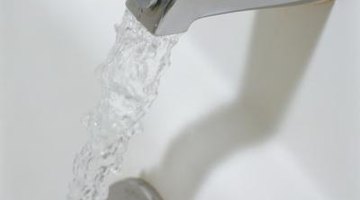Slow-Running Bathtub Faucets
A bathtub faucet's water pressure or flow may decrease slowly over the space of weeks or months, or the decrease may happen within a day or a few hours. Once you notice that the faucet is running slower than before, take action before the flow of water potentially cuts off altogether.
Aerator Problems

Some bathtub spouts come with an aerator, like ones you find on the end of a sink's spout. An aerator looks like a small mesh screen in the spout's opening. The aerator helps catch sediment before it comes out of the spout, saving you from finding grit not only in your glass of water but also in the bottom of your bathtub. The problem arises when enough sediment is trapped by the aerator that the water flows very slowly out of the spout. Cure this by using a wrench, wrapped in electrical tape to protect the finish, to twist the aerator off the end of the spout. Rinse the aerator to flush out the sediment and then reinstall it.
Valve Problems
Like the aerator, the faucet's water valve or valves may become clogged with sediment. Shut off the water to the faucet, and remove the handle and any other components blocking access to the faucet valves. Once you remove the valves, rinse any sediment clinging to them and then use an old toothbrush to scrub the sediment out of the pipes where the valves sit. Also, use a rolled up paper towel to clean out the pipes before you reinstall the valves and other faucet components.
Source of Sediment
The sediment you find in your faucet can result from hard water buildup in your house plumbing or even in the city's water supply lines. The sediment will break off the inside of the pipes over time, but the process will be accelerated by a sudden change in water pressure, like when you shut off the water in your house and turn it back on. Turning the water back on in your house slowly will help reduce the problem. Plumbing repairs, including installation of new pipes, will cause pipe shavings and pieces of solder to travel down the pipes, where they become stuck in the faucet. Turning on an outside water faucet after you have restored the water in your home will help flush the sediment out of the system.
Faucet Shutoff
Another possible cause of a slow faucet is that the shutoff valves for the faucet are not open all the way. If you have an access panel cut out in the wall directly behind the bathtub's faucet, you likely have access to one hot and one cold water shutoff valve. Twisting the handles counterclockwise as much as possible will open the valves all the way, delivering the full flow of water to the faucet.
References
Photo Credits
- Ryan McVay/Photodisc/Getty Images
More Articles



